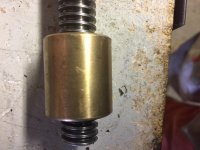Ordering The rod
McMaster Carr
Sorry can't find the order yet but I think it may have been from McMaster-Carr.
McMaster-Carr. I will look for the spare screw tomorrow.[/QUOTE]
Thank you for looking.
I could have purchased the complete screw and nut from ebay for around $245. There are a couple of people selling them.
I decided that I wanted to make the lead screw myself. I would have made the nut as well but I couldn't find a 5/8x8 TPI LH Acme thread gauge. Not that I looked very hard. So I wasn't willing to make both parts, even if I had been able to make it to the specifications, I would never be sure enough.
I ordered the nut from ebay, as I said, and it will arrive tomorrow. The 8TPI Acme insert arrived yesterday, along with real thrust bearings and washers.
When I got the lathe, somebody had managed to put the cross feed screw together in such a way that it was locked to the Taper Assembly and would not move. I.e. the T.A. was disabled. Because I didn't have a real clue what I was doing, I ended up making a thrust bearing out of some bronze I had in hand. It has worked just fine, but I think roller thrust bearings are the correct path to take.
My issue is that the Stressproof I ordered from Speedymetal hasn't shipped yet. I could have purchased from a nearly local supply house and had the stock but no, I was cheap and ordered it online. Which means I might not get shop time this weekend.
Because I'm moving to roller thrust bearings, I am likely going to be slightly modifying the lead screw. The O.D. of the thrust bearings is correct, it has to fit through the T.A. Casting if I'm going to put it in from the rear like I want to. But the I.D. for the back bearing is 0.500 and the OD of the screw where it rides is 0.4375. I might make that a little larger and I might change the threading from 7/16x14 to 1/2x13 just so it all fits the standard bearings I want to use.
I've done a number of cleaning and adjusting tasks on the lathe and mill, but this will be the first replacement parts I've put in and the first time I've made a part for them. I'm excited.
When this is done, I'm going to take the power feed from the mill apart again and make some replacement gears/parts for it and put it back in service.
FYI: ebay for nut and screw $245. Cost for raw materials and tooling: $60 for nut, $50 for insert and bearings, $75 for two pieces of 2 foot long stressproof+shipping.





 Used ordinary 5/8 11 TPI threaded rod. A brass nut soldered into a post. Works but of course the dial indicator is out to lunch and have to pay close attention that the feed is opposite which is very annoying. At least I could get to use my lathe until parts arrived. Never researched if LH rod was available locally. If this setup was to be used for any length of time it would be worth it.
Used ordinary 5/8 11 TPI threaded rod. A brass nut soldered into a post. Works but of course the dial indicator is out to lunch and have to pay close attention that the feed is opposite which is very annoying. At least I could get to use my lathe until parts arrived. Never researched if LH rod was available locally. If this setup was to be used for any length of time it would be worth it.
